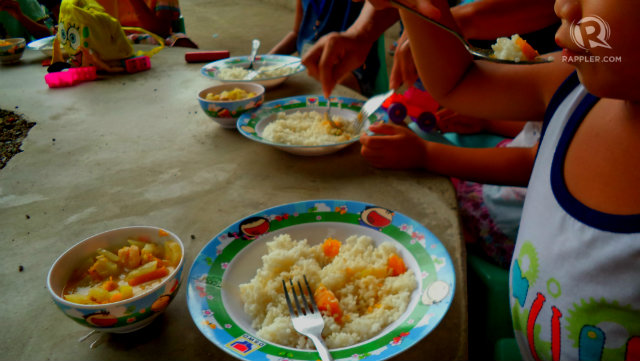SUMMARY
This is AI generated summarization, which may have errors. For context, always refer to the full article.

MANILA, Philippines — What does misinformation do to nutrition?
Various government and non-governmental organizations (NGOs) have been coming up with programs addressing the country’s hunger problem. Sometimes these programs work, sometimes they don’t.
All of them may mean well, but good intentions alone may not be enough. What happens if the people who are trying to help also need help?
Chona Calayu, the head of an NGO in Marinduque admitted that she has never heard of “stunting” or being too short for one’s age. She first learned about it while attending a forum organized by the Food and Nutrition Research Institute (FNRI) in 2014, only after operating the NGO for the past 26 years.
Calayu’s NGO conducts a supplementary feeding program (SFP) for 5-year-olds. She only recently found out that most of their beneficiaries are stunted. This means that the problem lies in their nutritional status before they even turned 5.
“In MIMAROPA, stunting is a public health problem. It’s above the national average. There are improvements, but very slight,” said Ma. Lilibeth Dasco, FNRI senior science research specialist. In Marinduque alone, the stunting prevalence among children aged 5 and below was 32.9% in 2013.
The effects of stunting on the mind and body are irreversible, which is why the first 1,000 days or two years of life are crucial. “This is a window of opportunity. Nutrition is from conception to birth,” said Dr Rodolfo Florentino, president of the Nutritional Foundation of the Philippines and former FNRI director.
The FNRI added that although SFPs can help address wasting or being too thin for one’s height, it does not solve stunting.
“We should’ve focused on infants and pregnant women too, as well as nutrition education,” the NGO head said.
“It’s important to know if we’re implementing the right interventions,” said Carina Santiago, regional nutritional program coordinator of the National Nutrition Council (NNC) in MIMAROPA.
False, health
False childcare practices can lead to serious consequences, warned the NNC.

Perlas also observed that some parents continue to exclusively breastfeed their babies for an extended period. “Exlcusive breastfeeding is advised for the first 6 months, but breast milk alone beyond that will be insufficient,” she explained. “Some mothers begin complementary feeding on the 8th month, which is already very late.”
Nutrition surveys have suggested a correlation between children’s nutritional status and their family’s socioeconomic class. “As income increases, meal frequency tends to increase too,” Dasco said. “However, this does not always mean an acceptable diet. Sometimes families, even if they can afford to, don’t invest on nutrition. They spend more on children’s expensive toys or gadgets.”
At the grassroots level, the FNRI suggested working on improving children’s dietary diversity. This means that children should be introduced to different types of nutritious food, not only to entice them to eat, but to eat well.
Misinformation, however, not only exists among homes, but could also thrive in schools or LGUs.
Perlas shared how the Department of Health found how some school deworming programs fail. “Some children don’t really take the medicine. They spit it out.” She advised schools to closely monitor this by inspecting the child’s tongue, “If there’s discoloration, it means they took the medicine.”
Schools are also advised to educate not only the students, but also their parents on the importance of deworming and proper hygiene.
Another commonly used but misunderstood term is “malnutrition.”
“When we say malnutrition, this includes undernutrition and overnutrition. We only think of the wasted and stunted children, we should also be concerned with overweight and obesity,” said Dr Corazon Barba, former FNRI director.
The NNC added that overweight women are at higher risk of delivering low birth weight babies.
Feeding?
“Supplementary feeding programs (SFP) should have a nutritional objective; unfortunately, not all of them do,” Barba said.
A nationwide SFP targeting undernourished public elementary students and preschoolers is being led by the Department of Education and the Department of Social Welfare and Development. Some LGUs also conduct their own SFP.
Barba said that although there are national policies on health, since programs are devolved, the interpretation of such policies rely heavily on LGUs. “SFPs should address what is lacking. For example, at least one-third of a child’s Recommended Dietary Intake,” she said.
Some SFPs only aim to “fill an empty stomach,” without actually providing the right nutrition.
“Supplementary feeding programs take a lot of budget, it can drain resources. Some families become dependent; instead of being supplementary, it becomes a substitute for regular meals,” Dasco stressed. “SFP needs to be paired with nutrition education.”
Dasco advised groups conducting SFPs to review their strategies, noting that it is possible for a child to become obese while remaining stunted. “The government should monitor SFPs and make sure they have nutritional objectives, especially since government funds are used,” Barba added.
Culture, food
The latest nutrition survey showed that undernutrition in Mindoro is quite high. “But we should consider that the survey may have included Mangyan families. In their culture, they only eat once a day,” explained Dr Arneli Rembong, provincial nutrition action officer of Occidental Mindoro.
Rembong added that the effects of intervention programs may take a while to manifest.
“When we go around, we observe problems like sanitation and malnutrition among some IP communities,” said Jovie Raval, NNC chief of nutrition information and education.
“Hopefully we can reach out, without invading their culture. We hope they can eat healthy, but still in line with their culture,” Raval added. For example, families may start eating a more diverse diet instead of just eating root crops.
Dasco stressed that ethnicity should not be a factor during the first 5 years of life since all children need “optimal care and feeding.”
Meanwhile, Calayu promised to share her new learnings with her colleagues back in Marinduque. “We’ve got a lot of work to do,” she said. – Rappler.com
How else can we help fight hunger? Recommend NGOs, report what your LGU is doing, or suggest creative solutions. E-mail us at move.ph@rappler.com. Be part of the #HungerProject.
Add a comment
How does this make you feel?

There are no comments yet. Add your comment to start the conversation.